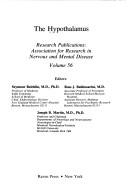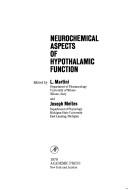| Listing 1 - 10 of 10 |
Sort by
|
Book
ISBN: 0080181708 Year: 1975 Publisher: Oxford ; New York : Pergamon Press,
Abstract | Keywords | Export | Availability | Bookmark
 Loading...
Loading...Choose an application
- Reference Manager
- EndNote
- RefWorks (Direct export to RefWorks)
Obstetrical endocrinology --- Hormones --- Hypothalamo-hypophyseal system --- Hormones --- Hypothalamo-Hypophyseal System --- Pregnancy --- Congresses. --- Analysis --- Congresses. --- Congresses. --- Congresses. --- Congresses. --- Congresses.
Book
ISBN: 1789844452 1789844444 1838814078 Year: 2018 Publisher: IntechOpen
Abstract | Keywords | Export | Availability | Bookmark
 Loading...
Loading...Choose an application
- Reference Manager
- EndNote
- RefWorks (Direct export to RefWorks)
The human hypothalamus, a small structure at the base of the brain, has strategic importance for the harmonic function of the human body. It controls the autonomic nervous system, neuroendocrine function, circadian and circannual rhythms, somatic activities, and behavior, and is situated at the borders between the brain and the body and the brain and the soul, meeting points for mind and body. The hypothalamus is involved in a wide range of higher mental functions, including attention, learning and reinforcement of mnemonic processes, emotional control, mood stability, and cognitive-emotional interactions. It also has a role to play in behavioral disorders, panic reactions, cluster headache, gelastic epilepsy, mental deficiency, periodic disorders, depression, autism, and schizophrenia, and in a substantial number of neurodegenerative diseases. It enlarges greatly the dimensions of the hypothalamic contribution in controlling psychosomatic equilibrium and retaining internal unity of the human existence.
Hypothalamus. --- Diencephalon --- Endocrine glands --- Hypothalamo-hypophyseal system --- Limbic system --- Life Sciences --- Neuroscience --- Neurophysiology

ISBN: 9780893520175 0893520179 Year: 1978 Publisher: New York : Masson Pub. USA,
Abstract | Keywords | Export | Availability | Bookmark
 Loading...
Loading...Choose an application
- Reference Manager
- EndNote
- RefWorks (Direct export to RefWorks)
Gonadal Steroid Hormones --- Gonadotropins --- Hypothalamo-Hypophyseal System. --- Pregnancy --- Endocrinology --- Hormones, Sex

ISBN: 0890041679 Year: 1978 Volume: 56 Publisher: New York Raven Press
Abstract | Keywords | Export | Availability | Bookmark
 Loading...
Loading...Choose an application
- Reference Manager
- EndNote
- RefWorks (Direct export to RefWorks)
Glandular physiology --- Physiology of nerves and sense organs --- Hypothalamus --- Neurosecretion. --- Hypothalamus. --- Hypothalamo-hypophyseal system. --- Hypothalamic hormones. --- Neuroendocrinology. --- Neuroendocrinologie --- physiology.
Book
ISBN: 9782889196340 Year: 2015 Publisher: Frontiers Media SA
Abstract | Keywords | Export | Availability | Bookmark
 Loading...
Loading...Choose an application
- Reference Manager
- EndNote
- RefWorks (Direct export to RefWorks)
The hypothalamus is the region of the brain in charge of the maintenance of the internal milieu of the organism. It is also essential to orchestrate reproductive, parental, aggressive-defensive, and other social behaviors, and for the expression of emotions. Due to the structural complexity of the hypothalamus, however, many basic aspects of its ontogenesis are still mysterious. Nowadays we assist to a renewal of interest spurred in part by the growing realization that prenatal and early postnatal influences on the hypothalamus could entail pathological conditions later in life. Intriguing questions for the future include: do early specification phenomena reflect on adult hypothalamic function and possibly on some kinds of behavior? Can early events like specification, migration or formation of nuclei influence adult hypothalamic function? A change in morphological paradigm, from earlier columnar interpretations to neuromeric ones, is taking place. Concepts long taken for granted start to be challenged in view of advances in developmental and comparative neurobiology, and notably also in the molecular characterization of hypothalamic structures. How should we understand the position of the hypothalamus in relation to other brain regions? Should we bundle it together with the thalamus, a functionally, genetically and developmentally very different structure? Does the classic concept of “diencephalon” make sense, or should the hypothalamus be separated? Does the preoptic area belong to the hypothalamus or the telencephalon? The answer to these questions in the context of recent causal molecular analysis will help to understand hypothalamic evolution and morphogenesis as well as its adult function and connectivity. In this Research Topic we have reviewed the fundamentals of hypothalamic ontogenesis and evolution, summarizing present-day knowledge, taking stock of the latest advances, and anticipating future challenges.
Hypothalamus. --- Diencephalon --- Endocrine glands --- Hypothalamo-hypophyseal system --- Limbic system --- circadian --- Shh --- MCH --- Oxytocin --- thyroid --- Notch --- Nkx2.4 --- prosomeric --- Cadherins --- Mammillary

ISBN: 0124755607 9780124755604 Year: 1970 Publisher: New York : Academic Press,
Abstract | Keywords | Export | Availability | Bookmark
 Loading...
Loading...Choose an application
- Reference Manager
- EndNote
- RefWorks (Direct export to RefWorks)
Brain Chemistry --- Hypothalamo-Hypophyseal System --- Hypothalamus --- Pituitary Hormone Releasing Hormones --- Neurochemistry --- Neurochimie --- congresses --- physiology --- Congresses --- Congrès --- Congresses. --- Congrès --- congresses. --- Pituitary Hormone-Releasing Hormones --- Hypothalamus - Congresses --- Neurochemistry - Congresses
Book
ISBN: 3030621871 3030621863 Year: 2021 Publisher: Cham, Switzerland : Humana Press,
Abstract | Keywords | Export | Availability | Bookmark
 Loading...
Loading...Choose an application
- Reference Manager
- EndNote
- RefWorks (Direct export to RefWorks)
The hypothalamus is an anatomically small but functionally important part of the brain. In functional and pathophysiological terms, the hypothalamus represents the intersection of several areas of clinical and medical expertise. The human hypothalamus can be astutely referred to as the crossroad of endocrinology, psychiatry, neurology and neurosurgery. Because of its involvement in myriad physiologic functions and the varied ways disorders involving it can manifest, hypothalamic disease can initially come to medical attention in widely disparate settings and with widely different clinicians. Therefore, the detection and proper care of hypothalamic dysfunction and disease often requires carefully coordinated multidisciplinary care. This volume fills a significant void in the medical professional community, comprehensively presenting the scope of hypothalamic structure, function, dysfunction and disease to cater to the various clinical, teaching and research professionals that have a stake in this part of the human brain. This text captures in one place all the information that practicing clinicians, clinician scientists, and researchers need to be adequately informed about various aspects of the hypothalamus in all its complexity. It is comprehensive and broad in scope so that it provides relevant reference information for the wide range of professionals involved in the pre- and post-mortem detection, diagnosis, characterization, care and management of various hypothalamic disorders and diseases in addition to providing a sound anatomic and physiologic foundation of the normal human hypothalamus. The Human Hypothalamus can be used to differing degrees by medical professionals and students alike, finding utility for interested general clinicians, medical school and allied health professional teaching faculty as well as subspecialists in domains as wide as neurosurgery, neuroendocrinology, clinical psychiatry and neuro-oncology.
Endocrinology . --- Neurology . --- Endocrinology. --- Neurology. --- Medicine --- Nervous system --- Neuropsychiatry --- Internal medicine --- Hormones --- Diseases --- Hypothalamus. --- Diencephalon --- Endocrine glands --- Hypothalamo-hypophyseal system --- Limbic system
Book
ISBN: 0852242042 9780852242049 Year: 1971 Volume: 6 Publisher: Edinburgh Edinburgh University Press
Abstract | Keywords | Export | Availability | Bookmark
 Loading...
Loading...Choose an application
- Reference Manager
- EndNote
- RefWorks (Direct export to RefWorks)
Pathological endocrinology --- Pituitary hormone releasing factors --- Steroid hormones --- Hormones, Sex --- Congresses --- Metabolism --- Gonadotropins, Pituitary. --- Steroids. --- Catatoxic Steroids --- Steroids, Catatoxic --- Pituitary Gonadotropins --- Conferences - Meetings --- GONADOTROPINS --- STEROIDS --- Congresses. --- PITUITARY --- Gonadotropins, Pituitary --- Steroids --- Hormonal steroids --- Hormones --- Hypothalamic hypophysiotropic hormones --- Hypothalamic hormones --- Hypothalamo-hypophyseal system --- Metabolism&delete& --- Steroid --- Pituitary hormone releasing factors - Congresses --- Steroid hormones - Metabolism - Congresses --- Hormones, Sex - Congresses --- Gonadotropins --- Pituitary
Book
ISBN: 3319566911 331956689X Year: 2017 Publisher: Cham : Springer International Publishing : Imprint: Springer,
Abstract | Keywords | Export | Availability | Bookmark
 Loading...
Loading...Choose an application
- Reference Manager
- EndNote
- RefWorks (Direct export to RefWorks)
This work details contemporary clinical knowledge on the multidisciplinary management of pituitary and other sellar/parasellar tumors, with a focus on surgical techniques and a particular emphasis on complication avoidance and management. International experts provide guidance on natural history, radiologic and clinical aspects, surgical indications, and resection techniques.In addition, case presentations and clinical photographs help the reader reduce the risk of error and advance their own surgical skills. Readers also have access online to streaming videos of key procedures to help them provide the best possible outcomes for every patient. Transsphenoidal Surgery: Complication Avoidance and Management Techniques will be of great value to Neurosurgeons, Otolaryngologists, Endocrinologists, Radiation Oncologists, and residents and fellows in these specialties.
Medicine. --- Endocrinology. --- Neurosurgery. --- Surgical oncology. --- Medicine & Public Health. --- Surgical Oncology. --- Pituitary gland --- Sphenoid sinus --- Tumors --- Surgery. --- Sinus sphenoidalis --- Sphenoidal sinus --- Paranasal sinuses --- Hypophysis cerebri --- Pituitary body --- Brain --- Endocrine glands --- Hypothalamo-hypophyseal system --- Cancer --- Oncologic surgery --- Oncological surgery --- Surgical oncology --- Nerves --- Neurosurgery --- Internal medicine --- Hormones --- Excision --- Treatment --- Surgery --- Endocrinology .
Book
ISBN: 3319228544 3319228552 Year: 2016 Publisher: Cham : Springer International Publishing : Imprint: Springer,
Abstract | Keywords | Export | Availability | Bookmark
 Loading...
Loading...Choose an application
- Reference Manager
- EndNote
- RefWorks (Direct export to RefWorks)
This book presents, in a stepwise and interactive fashion, approximately 75 clinical-pathological entities that reflect the wide spectrum of pathology encountered in the sellar and parasellar region and have been gathered over a period of decades by the authors. Multiple examples of high-quality radiologic and histopathologic images depicting the differentiating features of the varying lesions are presented, and key operative and clinical management pearls are briefly reviewed in a concise, bullet point format. The interdisciplinary nature of this easy-to-use color atlas and textbook reflects the fact that the management of patients with sellar and parasellar lesions is itself often interdisciplinary,making this atlas a useful resource for any practitioner or trainee who cares for patients with pituitary disease and anterior skull base pathology. The format is unique in that no similar interdisciplinary book is dedicated specifically to the comprehensive catalogue of lesions in this intricate region of the brain and skull base. Atlas of Sellar and Parasellar Lesions: Clinical, Imaging, and Pathologic Correlations is of great value for practitioners and trainees in a range of medical specialties, including radiology, neurology, endocriniology, pathology, oncology, radiation oncology, and neurosurgery.
Surgery - General and By Type --- Surgery & Anesthesiology --- Health & Biological Sciences --- Sella turcica. --- Pituitary gland. --- Skull base. --- Base of skull --- Basicranium --- Cranial base --- Hypophysis cerebri --- Pituitary body --- Pars sellaris --- Turkish saddle (Anatomy) --- Skull --- Brain --- Endocrine glands --- Hypothalamo-hypophyseal system --- Sphenoid bone --- Neurosurgery. --- Endocrinology. --- Radiology, Medical. --- Imaging / Radiology. --- Clinical radiology --- Radiology, Medical --- Radiology (Medicine) --- Medical physics --- Internal medicine --- Hormones --- Nerves --- Neurosurgery --- Surgery --- Endocrinology . --- Radiology. --- Radiological physics --- Physics --- Radiation
| Listing 1 - 10 of 10 |
Sort by
|

 Search
Search Feedback
Feedback About UniCat
About UniCat  Help
Help News
News